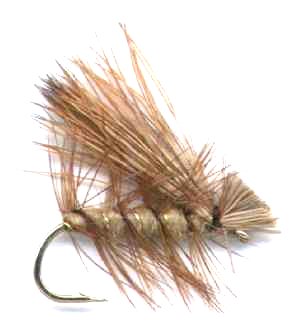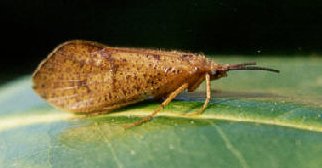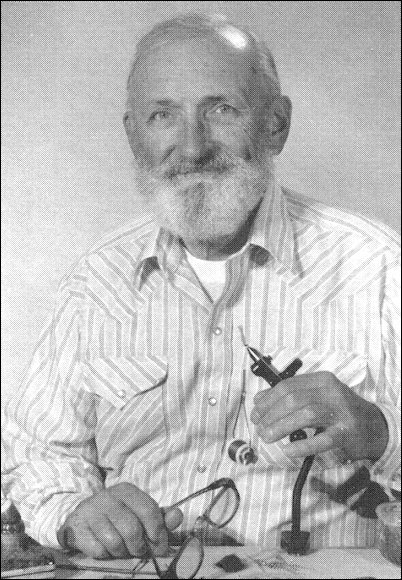Tan Elk Hair Caddis (Sedge) Fly
Fly Fishing Tan Elk Hair Caddis using the "Dribbling" method. - During the late afternoon when flies are starting to hatch you can imitate the natural newly hatched caddis insect trying to take off from the water surface using a Tan Elk Hair Caddis fly pattern.

CADDIS FLY PATTERNS. Hook size 10 12 14 16 18 20 - $US each
You do this by dragging the tail of the fly on the water surface so that is either flickers among the ripples or makes a V shape report in the current. This also works on days where there is a gusty breeze and the trout have already seen insects being blown onto the water surface from the land. This method of fishing has been given the term "dribbling" because of the way the fly is dribbled across ripples in the water surface. It is best used on narrow fast flowing areas for a medium-sized River in places where the angler can get close the water and I just raising his rod tip, bring the fly onto the water surface. The way the wing is shaped on the Tan Elk Hair Caddis fly in a fan shape helps produce the V shaped ripple as it is retrieved over the water surface. It also matched the silhouette of an adult Caddis wings.
Many caddis patterns originate in the USA like the Elk Hair caddis and the stimulator. My first line of attack is with a stimulator fly pattern. It works well as a searching pattern. It can be fished static as a single point fly or cast to rising fish. It has exceptional buoyancy and produces aggressive slashes and follows when whipped across the top. The winning combination of the colors and the way it rides through the water are the reason why it is so effective. The elk hair caddis is considered by many to be one of the most effective general purpose caddis patterns. Like the Gold Ribbed Hare’s Ear nymph it represents everything and nothing. If targeting rising trout, use it as a single point fly with a floating line and a long leader. Alternatively use one as the top dropper with a team. The wing fiber butts that form the head create a useful fish attention grabbing disturbance in the water’s surface during the retrieve.

Dry fly fishing can be very frustrating, challenging as well as enjoyable. On a simple level all you do when you see a trout rise to a floating natural caddis is to drop a reasonable imitation like a tan elk hair caddis dry fly above the fish and let the current bring the fly over the waiting feeding trout’s head. For the dry fly fisherman everything is visible unlike when nymphs and wet flies are used. Then the subsurface angler has to make his team of flies search the eddies and runnels between weed beds for hungry trout and grayling.
So why is it frustrating? Most fly fishermen have seen one or two surface feeding trout rise to something on the surface that is invisible. If you cannot see what they are eating how can you match the hatch? Another annoying difficult situation can occur when there are two different insect species hatches happening at the same time. This mainly happens in the evening. You then have to work out if the trout are taking Blue Winged Olives of caddis. Which one are they fixating on? Many anglers go through their fly box to work out what imitation will work best. My advice is don’t.
I have found that the caddis fly imitation always wins out over a mayfly pattern in the evening. Why would this be so? There is no science behind this other than observation. The caddis flies present a bigger profile and offer a slightly more substantial meal. What would you eat if you were hungry and offered a choice between a thin flat child’s chocolate button or a square of chocolate from a bar. It is the same choice the trout have; they are presented with similar food but one is slightly more filling.
If a rising trout is continually refusing my offering of a tan elk hair caddis of the right size I do not change the pattern. Instead I have found it more productive to change my location and angle of attack. I have found that my fly has been refused either because the angle of light on it is giving a wrong profile to the subsurface trout looking up or an unseen unnatural looking ripple caused by a tiny bit of drag on my line, leader or tippet is putting them off.
I let the line dead drift past the feeding trout. Before I lift the line I give it a little tweak in an effort to imitate the natural movement of a crippled caddis just in case my drifting fly is being followed. At the end of the drift I skate the fly over the surface for a short distance to create the tell-tale V wake of a natural caddis fly taking off from the surface for the first time. I have had some explosive takes just as my fly leaves the water surface.

Fly Fisherman Al Troth designed the popular Elk Hair Caddis dry fly
LINKEDIN COMMENT
In Colorado, the Elk Hair Caddis is by far my favorite and most productive fly. I've of course crushed it on warm days with hatches happening all around me. However I can often coax a trout to rise on a winter day with very little to no surface activity going on with a well placed Caddis. I typically will cast upstream sending the fly strait down the middle of the riffle a few times to see if get any takers, then I start working the edges of the riffle where the moving water meets the calmer. One of my best browns was taken casting a Caddis downstream into an eddy just before a waterfall. There is a logjam there and if you cast just to the side of the main flow, the whirlpool effect will circle your fly around the logs before it gets to the waterfall. Then bam, giant trout that was hiding under those logs sees your fly (camouflaged slightly by the foam that is in the eddy), and you're in business! I always buy barb-less hooks or crimp the barbs down for easy release. Unless I see a hatch of something else coming off, the first fly I throw is almost always a size 14-18 Elk Hair Caddis. Dane Thorne, USA
LINKEDIN COMMENT
How to fish a Caddis Dry fly:- I have sort of drifted away from the elk hairs after many years when they were the only caddis pattern I carried. Now I use the headlight caddis almost exclusively as my searching fly, and any time spent flies are on the water. Still carry an array of elk hairs and like them for "skittering" when fish are potshotting at egg layers. By John Carr
GOOGLE+ READER'S COMMENT
I fish a size 14 modified version of the Elk Hair Caddis as an attractor from May to October. Usually dead drift but some times it has to skitter to get them to come up. When it matches the "hatch" I use it 90% of the time. Earl Arnold, USA
LINKEDIN COMMENT
How to fish a Caddis Dry fly:- Good question, I don't believe I really have. I just stick with the good old tan Elk Hair. I have a few olive, black, and brown colored bodies in the box. When I see a trout rise for the fly and refuse it at the last second, I'll sometimes switch it up a bit. I will try a different size or color variation, or clip the hackle and usually they will eventually take it. But 9 out of 10 times, I just keep throwing that same bug until they decide they like it. I think the basic Elk Hair Caddis is the best dry fly out there, so why try to fix what isn't broken or reinvent the wheel? I also have the luxury of fishing some fairly remote areas that get little pressure so the fish aren't as picky. With a good presentation, they'll eat about anything the see floating by them.? By Dane Thorne

